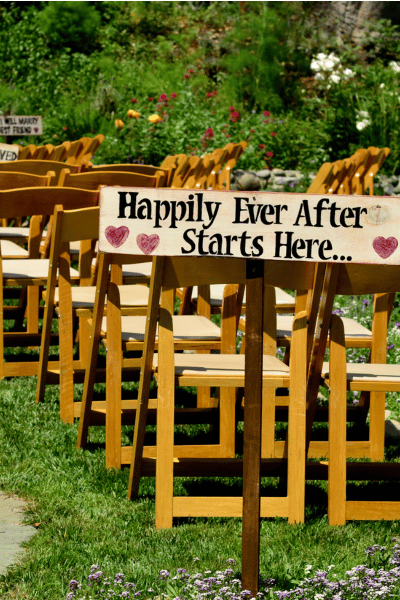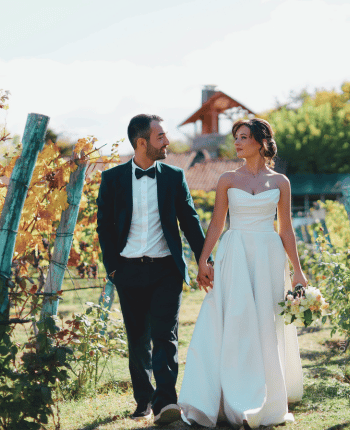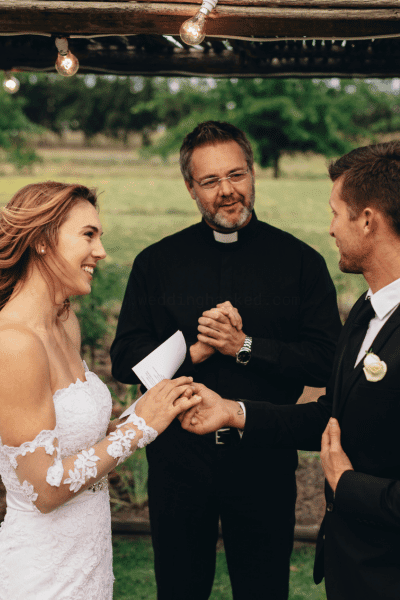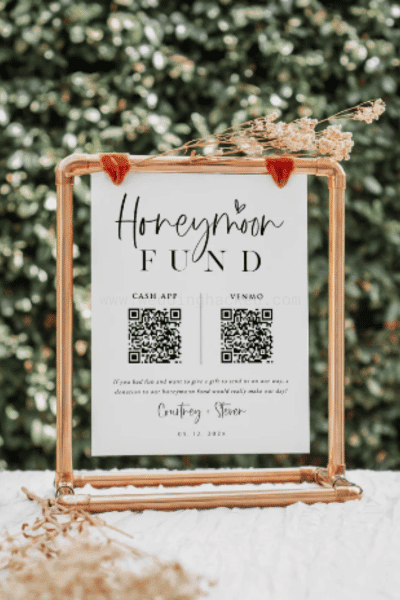12 Important Parts Of A Wedding Ceremony You Should Know About
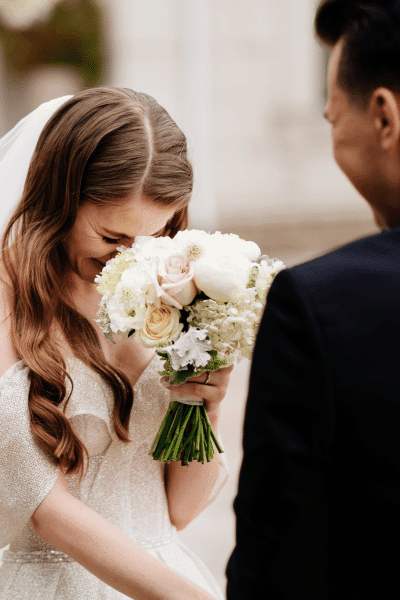
Understanding the different parts of a wedding ceremony is essential whether you’re planning, attending, or participating in one. Each segment of the ceremony has its unique significance and contributes to the overall flow and meaning of the event. For planners, knowing these parts ensures nothing is overlooked and helps create a seamless experience. For participants with specific roles, it allows them to perform their duties with confidence and respect for tradition. This post will guide you through the various components of a wedding ceremony, and what to expect!
Different Parts of a Wedding Ceremony
A wedding ceremony is a structured event that signifies the union of two individuals in marriage. Each part of the ceremony has its own significance and adds to the overall experience. Here’s a breakdown of the different parts of a traditional wedding ceremony, with short paragraphs describing each part:
1. The Prelude
The prelude is the period before the official start of the wedding ceremony, typically lasting between 15 to 30 minutes. This time allows guests to arrive, find their seats, and settle in before the main events begin. It’s a crucial segment for setting the stage and creating the right ambiance for the ceremony.
Typical Activities During This Time
- Guest Seating: Ushers or wedding coordinators guide guests to their seats. This process helps organize the seating arrangement, ensuring that close family members and friends are seated in designated areas.
- Music: Soft, background music is usually played during the prelude. This can be a live performance by musicians or a curated playlist that complements the theme and mood of the wedding.
- Socializing: Guests often take this time to greet each other, catch up, and share in the excitement of the upcoming ceremony.
- Last-Minute Preparations: Behind the scenes, final touches are being made. The wedding party is getting ready, photographers are capturing candid moments, and coordinators are ensuring everything is in place.
Importance of Setting the Mood
Setting the right mood during the prelude is essential as it influences the overall atmosphere of the ceremony. The choice of music, the organization of guest seating, and the general ambiance all contribute to creating a welcoming and emotionally resonant environment.
2. Processional
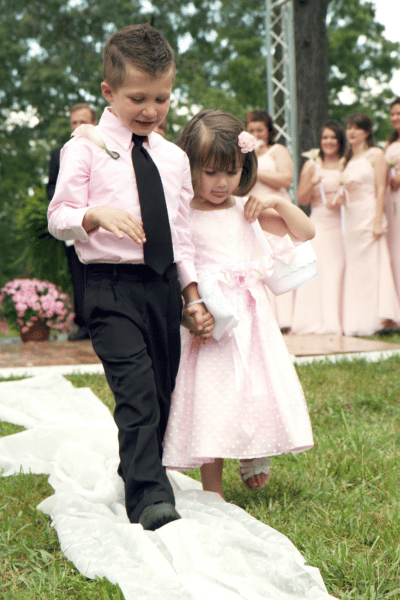
The processional is a pivotal moment in a wedding ceremony, marking the official beginning of the event. It involves the formal entrance of the bridal party, leading up to the grand entrance of the bride. This moment is rich with anticipation and emotion, as it symbolizes the transition from individual lives to a united future.
Who Walks Down the Aisle
- The Couple
- Bridal Party: Includes bridesmaids, groomsmen, maid or matron of honor, and best man.
- Family Members: Parents, grandparents, and other close family members may be part of the processional, each with their own significance.
- Children: Flower girls and ring bearers, usually younger relatives, add a touch of innocence and joy.
3. Welcome/Opening Remarks
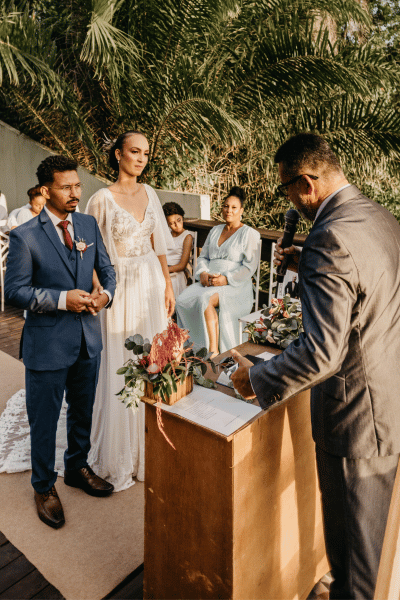
The officiant begins the ceremony with a warm welcome and an introduction that explains the purpose of the gathering. This part of the ceremony sets the stage, creating a connection between the guests and the couple. It often includes a few words about the significance of marriage and the unique love story of the couple.
Common Elements in Opening Remarks
- Welcome Message: Warmly greeting all guests and acknowledging their presence.
- Introduction of the Couple: Briefly introducing the couple and their journey together.
- Purpose of the Gathering: Highlighting the celebration of love and commitment.
- Cultural or Religious Elements: Including meaningful cultural or religious references.
- Acknowledgment of Family and Friends: Recognizing significant individuals and their contributions.
- Acknowledgment of Absent Loved Ones: Paying tribute to those who could not be present.
- Reflection on Marriage: Offering insights into the meaning and significance of marriage.
- Humor and Lightheartedness: Injecting humor to create a relaxed atmosphere.
Read More: Complete Officiant Speech Template For A Wedding In 2024
4. Readings
Readings are an integral part of many wedding ceremonies, serving to convey deeper meanings, shared values, and personal sentiments. They can be religious, secular, or personal, depending on the couple’s preferences and beliefs.
- Religious Readings: These are typically drawn from sacred texts and reflect the couple’s faith. Common examples include passages from the Bible, the Torah, the Quran, or other religious scriptures.
- Secular Readings: These may come from literature, poetry, or even favorite movies and songs. They often express themes of love, commitment, and partnership in a way that resonates with the couple and their guests.
- Personal Readings: These are often written by the couple or close friends and family members. They can include personal anecdotes, letters, or original poetry that holds special meaning for the couple.
5. Exchange of Vows
The exchange of vows is one of the most significant and emotional parts of a wedding ceremony. It is the moment when the couple makes their promises to each other, committing to a lifelong partnership. The vows represent the heart of the wedding, as they encapsulate the couple’s love, intentions, and commitments in their own words. This ritual not only formalizes the marriage but also allows the couple to express their deepest feelings and personal promises in front of their loved ones.
Traditional vs. Personalized Vows
- Consistency Vs. Individual Expression: Traditional vows often follow a set structure and use classic language that has been passed down through generations. Personalized vows allow couples to express their unique love story and promises in their own words.
- Cultural and Religious Significance Vs Emptional Impact: Traditional vows often carry deep cultural and religious significance, reflecting the heritage and beliefs of the couple. Personalized vows can be more poignant and relatable, often eliciting strong emotional reactions from both the couple and their guests.
Read More: 33 Wedding Vow Examples And Love Poems To Inspire Your Vows
6. Exchange of Rings
The exchange of rings is a deeply symbolic act within the wedding ceremony, representing the couple’s commitment, love, and eternal bond. The circular shape of the ring signifies infinity, with no beginning or end, symbolizing the everlasting nature of the couple’s union. Rings are traditionally worn on the fourth finger of the left hand, based on the ancient belief that this finger contains a vein that directly connects to the heart, often referred to as the “vena amoris” or “vein of love.” This act of placing the ring on each other’s finger signifies the couple’s vow to honor, cherish, and love one another forever.
7. Unity Ceremony
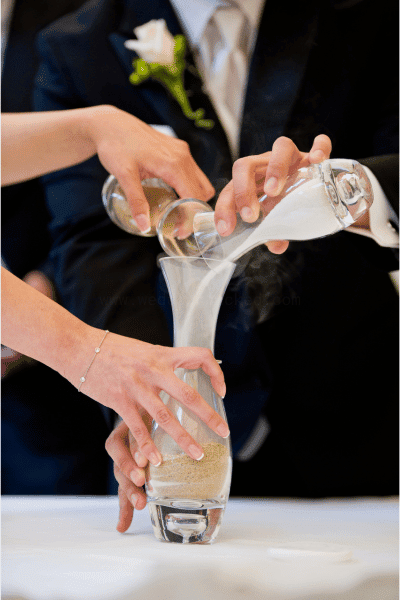
A unity ceremony is an optional but meaningful and symbolic act that represents the joining of two individuals into a single, unified partnership. This ritual is often incorporated into wedding ceremonies to visually and emotionally highlight the couple’s commitment to building a life together. Unity ceremonies can take various forms, each with its unique symbolism and personal significance.
Examples of Unity Ceremonies
Unity Candle: The bride and groom each take a lit candle and together light a larger, central candle. The flames of the smaller candles represent the individual lives, families, and experiences of the couple, which then unite to create a new, combined life symbolized by the central candle.
Sand Ceremony: The couple pours different colored sands into a single container, creating a layered pattern that represents their union. Just as the grains of sand intermingle and cannot be separated, the couple’s lives are joined together in an inseparable and unique way.
Wine Box Ceremony: The couple writes letters to each other and places them, along with a bottle of wine, into a wooden box. The box is sealed during the ceremony and is to be opened on a future anniversary. This ceremony symbolizes the couple’s commitment to maintaining their love and communication, with the box serving as a time capsule of their feelings and promises.
Tree Planting Ceremony: The couple plants a tree together, often using soil from each of their family homes. The tree represents growth, strength, and the nurturing of their relationship. As the tree grows and flourishes, so does their marriage.
Handfasting: A cord or ribbon is wrapped around the couple’s joined hands, binding them together in a symbolic act of unity. This ancient ritual symbolizes the binding of two lives and the promises they make to each other, often seen in Celtic traditions.
Unity Painting: The couple each paints a canvas, which when combined, creates a single piece of art. Often, this involves each partner adding their own colors or symbols to the painting. The painting represents their combined efforts to create a beautiful life together, blending their individual contributions into one cohesive and unique artwork.
8. Pronouncement of Marriage
The officiant formally declares the couple as married, marking the societal and spiritual culmination of the ceremony. This pronouncement is often accompanied by the traditional phrase, “I now pronounce you husband and wife,” and is followed by the couple’s first kiss as newlyweds. It is a moment of joy and celebration.
Cultural Variations in the Pronouncement
- Christian: The pronouncement often includes a blessing from God and an invitation for the groom to kiss the bride.
- Jewish: The ceremony concludes with the groom breaking a glass, followed by the pronouncement and joyous exclamation of “Mazel Tov!” from the guests.
- Hindu: The pronouncement often follows the Saptapadi (seven steps) ritual, where the couple takes seven steps together, each step representing a vow. The officiant then declares them as married.
- Native American: Pronouncements often incorporate elements of nature and spiritual guidance, with the officiant blessing the union with references to the earth, wind, fire, and water.
Read More: 12 Fantastic Gifts For A Wedding Officiant (With Recommendations!)
9. The Kiss
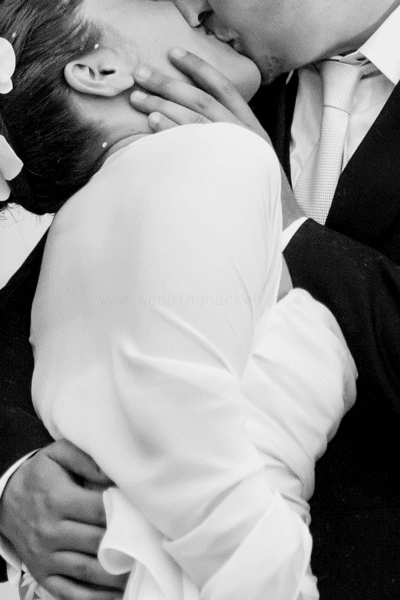
The kiss is the couple’s first act as a married couple, sealing their vows and commitment to each other. It is a joyful and symbolic gesture that signifies their union and is often greeted with applause and cheers from the guests. This moment is typically captured in photos and remembered fondly by the couple and attendees.
10. Closing Remarks
The officiant offers final words of congratulations and well-wishes to the couple. This moment is an opportunity for the officiant to offer final blessings, best wishes, and instructions for the rest of the event. The closing remarks help to solidify the significance of the ceremony and set a joyful tone for the festivities that follow.
Common Elements in Closing Remarks
Blessings: In religious ceremonies, the officiant may offer a final prayer or blessing, invoking spiritual guidance and support for the couple’s future together. In secular or non-religious ceremonies, the officiant may offer heartfelt wishes for the couple’s happiness and prosperity.
Formal Declaration: The officiant may formally acknowledge the couple’s new status as married partners.
Introduction to Guests: The officiant may introduce the couple to the guests using their new shared name, if applicable.
Logistical Information: The officiant may provide practical information about the next steps, such as directions to the reception venue, details about transportation, or timing for group photos.
Thanking the Guests: Expressing gratitude to the guests for their presence and support can make them feel appreciated and included in the celebration.
11. Recessional
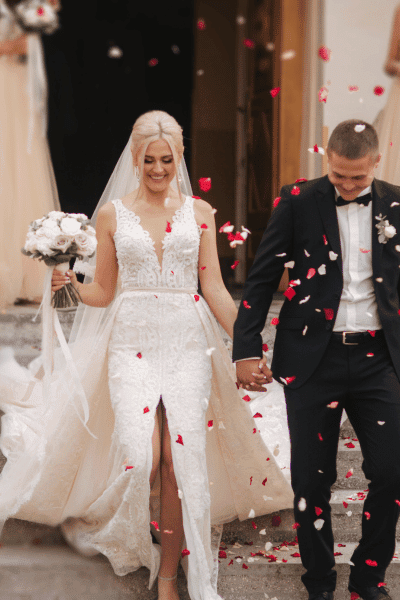
The recessional is the formal exit of the newlyweds, followed by the wedding party and guests. It signifies the conclusion of the ceremony and the beginning of the celebration. The couple often walks down the aisle together, hand in hand, as a symbol of their new journey as partners in life.
12. Postlude
The postlude is the music played as guests exit the ceremony space. It maintains a joyful and celebratory atmosphere, ensuring that the positive energy of the ceremony continues as guests transition to the reception or other post-ceremony activities. This music helps to smoothly guide guests to the next part of the wedding day.
Concluding Thoughts: Understanding the various components of a wedding ceremony can enhance your appreciation and experience of this joyous occasion. From the prelude to the recessional, each part of the ceremony plays a crucial role in celebrating the couple’s union and expressing their love and commitment. As you prepare to attend or participate in a wedding, let this guide help you navigate the ceremony with confidence and joy, knowing that you are part of a timeless tradition that celebrates love, commitment, and the beginning of a new chapter in the couple’s lives!


